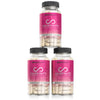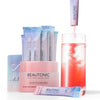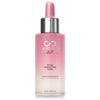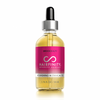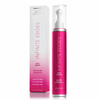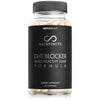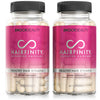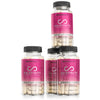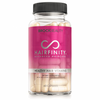
Here's What's Probably Causing Your Hair Breakage
Hair breakage is a fairly common occurrence in today's world, and it affects nearly everyone at some point. Is it pleasant to look at? No way! Fortunately for us, there are ways to combat it before it becomes visible. But, before you do so, you must understand what this breakage looks like and what might be causing it so that you can effectively plan how to deal with it.
"My hair doesn't grow" is a common complaint among people. Stress, diet, and even your particular hair product can contribute to hair breakage. People with all hair types, from straight to curly, may have experienced it at some point.
We'll look at the basics of hair breakage in this article, including what it looks like, what causes it, and what steps to address it.

The Appearance of Hair Breakage
Examine the hair you're losing very closely. Have you seen any frayed or broken strands? Shed hairs are usually approximately the same length as your hair and have a little white spot at the end. It's usual to shed between 50 and 100 hairs a day. However, you're probably suffering from hair breakage when you notice that the amount of hair that falls out is much shorter than normal, as well as when your hair seems parched and more brittle.
You know your hair is healthy when it always looks well moisturized with an intact and shiny layer and good elasticity.

What Factors Contribute to Hair Breakage?
A variety of factors can cause hair breakage. However, some people are more prone to hair breakage than others. Breakage is usually an issue for people who have curly or coarse hair textures, according to Toronto-based board-certified dermatologist, Geeta Yadav, M.D..
It is due to the scalp's inability to coat the entire length of the hair shaft with the oil it produces. The more rigid the coil or curl, the more prone to breaking it is.
He also says that older hair, especially white and gray hair, is bristly and doesn't let water in because it doesn't have enough elasticity. This means that it needs a break.
However, when your hair is colored, the damage it sustains is a possible cause of its breaking. It could be breakage if you enjoy bleaching and notice teeny-tiny strands all over you after a session.
According to Dr. Yadav, when you unduly process your hair, you're highly increasing the risk of breakage.
Also, chemicals that are very harsh, such as relaxers and bleach, tend to break down the hair's bonds, making it more fragile and susceptible to damage.
Hairstyling tends to stress your hair, resulting in breakage, so it's best to use a protectant.
It may interest you to know that tight buns, braids, and snatched ponytails, combined with constant baby hairstyling, tend to exacerbate the problem. Those tight styles may cause stress and strain on your hair strands, resulting in damage and breakage in the long term, even though they seem to be enjoyable and look ferocious as crazy.
Furthermore, it is really important to use utmost care with box and cornrow braids. Breakage is common in women's hairstyles with tighter coils or curls, especially if they are worn too often or improperly.
Other potential causes of hair breakage include:
1. Unhealthy eating habitsUnhealthy eating habits might have a negative impact on your hair more than a positive one. Don't neglect the importance of proper nutrition when it comes to maintaining a healthy glow on your hair and skin. Essential nutrients such as iron, zinc, and folic acid are required for good health. Eating meals strong in protein and antioxidants is also a good way to keep yourself healthy.
It's worth noting that eating problems may also lead to hair breakage. It's possible that someone with an eating issue isn't obtaining the nutrients they need for healthy hair. It might obstruct healthy hair development, leading your hair to fall out more often.
2. Dehydration
Hair that is dry and brittle is more prone to damage and breaking. This issue may be made worse by the use of harsh chemicals, frequent shampooing, and hot water washing. If you want to avoid dryness and breakage, apply a conditioner to your scalp immediately after cleaning. Try HAIRFINITY Balanced Moisture Conditioner, which reduces breakage up to 87% after just one use.
3. Brushing Too Thoroughly
Brushing your hair too forcefully might cause it to split into strands. It may also cause hair damage by stripping it of its roots. The American Academy of Dermatology recommends that you only brush your hair if you need to style it before heading out.
4. Heat-Producing Styling Tools
The scales of hair that are constantly exposed to extreme temperatures can fall apart and break. Allow time for your hair to air out. Allow it to breathe. Using a heat protectant, like HAIRFINITY Revitalizing Leave-In Conditioner, can also help to keep these tools from harming your hair. HAIRFINITY Revitalizing Leave-In Conditioner smoothes the hair cuticle for increased shine, strength and elasticity, reduces dryness, breakage and split ends, protects from heat damage and helps control frizz.
5. Using Chemicals on Your Hair Too Frequently
Hair that has been subjected to chemical treatments like relaxers and dyeing is more prone to breakage. Perming your hair may also be a significant factor. The use of chemical treatments on your hair regularly exposes it to potentially dangerous chemicals as well as heat, both of which may cause considerable damage. Hair chemical treatments should be avoided for at least six to seven months if you're experiencing severe breakage.
6. Not allowing it to dry naturally
Allowing your hair to air dry is critical for preventing long-term damage. Your hair is fragile when you get out of the shower. Using towels to dry your hair or using heat to dry your hair can cause damage to your hair.
7. Frequently tying your hair
Fastening your hair up often can cause it to become tangled, break easily and pull from its roots. Leaving your daily routine tied up is the best way to go.
What Medical Conditions Can Lead to Hair Breakage?
Dr. Yadav confirms that health conditions can play a role in hair loss. It is possible that hair loss and breakage might be caused by thyroid problems and inherited hair shaft issues, as well as nutritional inadequacies from an imbalanced diet or disordered eating.
Dr. Hartman believes that scalp fungus (mostly bacterial) folliculitis may also be to blame for the condition's onset. Of course, it's essential to seek medical attention in these cases in order to precisely identify the issue.
Furthermore, Hartman also said that stress is a health issue that might harm your hair. Increased amounts of stress hormones, especially cortisol, alter the hair cycle, according to Sadick. So, if your job is particularly stressful, or you're going through an emotionally unpleasant event, and you're experiencing hair breakage at the same time, contact your doctor to check whether stress is the cause of your issue.

Home Remedy for Hair Breakage
Certain hairstyles, taking vitamins, and using moisturizing products may all be done at home to help prevent hair breakage. The good news is that you have control over whether or not your hair breaks. It is, however, contingent on the circumstances surrounding your hair breakage.
In certain cases, supplementing with the correct vitamins might help you get back on track. If you want to maintain healthy hair, there are several vitamins and minerals you should keep in mind. B vitamins, D vitamins, and ferritin are only a few of them.
Biotin is the most often prescribed vitamin for healthy hair development. Although biotin deficiency is rare, it's still a good idea to visit your doctor to check whether you have it. Excess biotin intake may lead to a variety of issues, including acne. Zinc, iron, and selenium are three other minerals recommended by Dr. Yadav for healthy hair.
HAIRFINITY Candilocks Chewable Hair Vitamins is a tasty way to make sure you're getting the nutrients your hair needs every day. These chewable gummies are designed to promote healthier, stronger, longer hair.
Some hairstyling practices may have to be avoided in the process of restoring your hair. Take a break from styling and coloring your hair if you're having hair breakage and have recently used your hot tools, dyed your hair, or had chemical relaxers.
In the struggle against hair breakage, hair products play a crucial role. You can maintain your strong and healthy hair by keeping it moisturized, since damaged hair tends to be dry. Your best bet here is humectant (moisturizing) oils.
When applied topically, moisturizing substances like coconut oil and shea butter help lock in moisture and offer an emollient finish to help strengthen hair from the outside in. Do take into account your hair structure prior to dousing it with Jamaican black castor oil, though. Paul Jarrod Frank, M.D., a board-certified dermatologist in New York City, says that "heavier oils don't usually wash out and might make your hair feel heavy and greasy."
If you have fine hair that is prone to oil buildup, you may want to proceed with caution while using such products.
For the best results, when getting a shampoo, use an oily or dry hair type-appropriate shampoo that doesn't include sulfates. Deep conditioning treatments once a week are strongly recommended by Dr. Yadav, and we couldn't agree more.
The microfiber alternative to terry cloth towels, on the other hand, is considerably softer on your strands, so it's a smart idea to invest in one regardless of how terrible your hair is.
Protective styling, when done properly, may help those with curly or tightly coiled hair avoid damage. Make sure your style isn't too limited or changed, because this would defeat the point.
When should I cut off my breakage?
In some cases, your hair is so damaged that snipping the weak parts of the strand off is preferable to dealing with tiny hairs all over the place. Talk to your hairdresser first before deciding how much of your hair has to be trimmed back based on the level of your breakage.
According to an expert, "once the ends have started to split, there is no way to repair them." While different solutions may be used to temporarily "bandage" hair strands, the harm has already been done and the hair should be removed as soon as possible. It will help prevent the breakage from spreading up and causing damage to newer or younger growth.
Hair Reconditioning
Treating severely damaged hair necessitates extra care. With hair falling out so frequently, the only way to fully restore the damaged hair shaft is to grow healthy hair from the scalp, and as previously stated, hair grows about 1 cm per month, so new hair growth takes time. Once a hair-shaft disorder has been found, the best thing to do is to stop it from getting worse.
Below are a few practical steps to take with brittle or worn hair to avoid more damage as it grows out:
- When you shower or bathe, try not to wet your hair. It would help if you were to not wash your hair more than once a week. Do well to use a conditioner after washing, and leave it on for at least five minutes before rinsing. If your hair is clean, use conditioner instead of shampoo. After wetting the hair, lightly pat it dry rather than rubbing it with a towel.
- Also, avoid using hot combs or blow-drying your hair. Comb the hair with a wide-toothed comb no more than once a day. Brushing your hair too thoroughly is not a good idea. Try to avoid all harsh hairstyling techniques, like having your hair bleached, colored, straightened, permanently waved (permed), crimped, or pleated. Only sharp scissors, not a razor, should be used to cut the hair.
- Furthermore, wear a loose-fitting hat or scarf to protect your hair from excessive sun exposure; bathing caps and tight-fitting headgear should be avoided. Avoid pulling your hair back into a ponytail or braids, and to prevent friction when sleeping, use a satin pillowcase.
Conclusion
All that's left is for you to be kind to your hair now that you've got all the tools you'll need to identify and stop your breakage. Pay attention to your health and make sure you're obtaining enough nutrients.
It's impractical to think you'll never have another dye job or use a hot tool again, so if you're going to do something to your hair that could cause damage, do it under the guidance of a qualified expert, or, at the absolute least, adjust the heat setting on your curling iron.
















